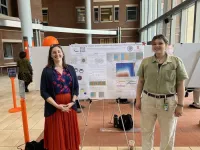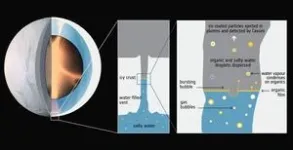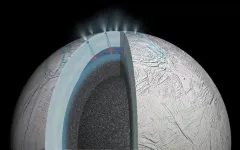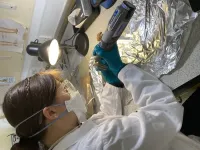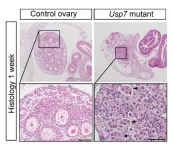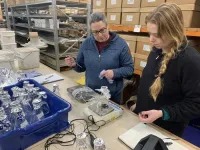(Press-News.org) Erin McCarthy ’23, physics summa cum laude, is a rarity among young scientists. As an undergraduate researcher in Syracuse University's College of Arts & Sciences’ Department of Physics, she guided a study that appeared in March 2024 in Physical Review Letters. It is the most-cited physics letters journal and the eighth-most cited journal in science overall.
McCarthy and postdoctoral associates Raj Kumar Manna and Ojan Damavandi developed a model that identified an unexpected collective behavior among computational particles with implications for future basic medical research and bioengineering.
“It’s very difficult to get a paper into Physical Review Letters,” said M. Lisa Manning, co-author, and the William R. Kenan, Jr. Professor of Physics as well as founding director of the BioInspired Institute at Syracuse University. “Your scientific peers must judge it as exceptional.”
McCarthy, a New Jersey native, chose Syracuse because of its “tremendous energy,” she said. “The educational and the research side of things was amazing. I came planning to be a physics major who was premed. I loved physics and biology, and I wanted to be involved in healthcare and medicine. And I got lucky in that I met Dr. Manning as a freshman, and she introduced me to computational biophysics. I started in research during my freshman year, which is extremely unusual.”
“Erin learned coding from scratch, and then did hours and hours of simulations, which took a lot of perseverance,” said Manning. “It’s just a fantastic testament to her work ethic and brilliance that this paper appeared in such a prestigious journal.”
The research team used computational physics modeling to figure out the underlying mechanisms that cause particles to sort spontaneously into different groups.
Learning how particles behave in physics models could provide insight into how living biological particles—cells, proteins and enzymes—remix themselves in development.
In the early stages of an embryo, for example, cells start out in heterogeneous mixtures. Cells must self-sort into different compartments to form distinct homogenous tissues. This is one of the major collective cell behaviors at work during development of tissues and organs and organ regeneration.
Erin McCarthy standing in front of the Physics Building during 2023 graduation weekend.
“Cells need to be able to organize themselves properly, segregating themselves to do their jobs,” said McCarthy. “We wanted to understand, if you remove chemistry and look strictly at physics, what are the mechanisms by which this reorganization can happen spontaneously?”
Previous physics investigations found that particles separate when some receive a jolt of higher temperature. As one population of particles becomes injected with energy at a small scale, it turns active—or “hot”—while the other population is left inactive, or “cold.” This difference in heat causes a reorganization among the two populations. These models are simplified versions of biological systems, using temperature to approximate cellular energy and movement.
“Hot particles push the cold particles aside so they can take over a larger space,” said co-author Manna. “But that only happens when a gap exists between particles.”
Previous modeling identified self-sorting particle behavior at less-packed, intermediate densities.
But the Syracuse team found something surprising. After injecting energy into a population of high-density particles, the hot particles did not shove cold ones around. The hot particles lacked space to do so.
That is important because biological particles—proteins in cells and cells in tissue—typically live in tight, crowded spaces.
“Your skin, for instance, is a very dense environment,” said McCarthy. “Cells are packed so closely together, there's no space between them. If we want to apply these physics findings to biology, we must look at high densities for our models to be applicable. But at very high densities, the difference in activity between two populations does not cause them to sort.”
There must be some other self-sorting mechanism at play in biology. “Temperature or active injection of energy does not always separate things, so you can’t use it in biology,” said Manning. “You must search for some other mechanism.”
To Manning, this study illustrates the strengths of Syracuse University. “The fact that an undergraduate spearheaded this research speaks to the awesome quality of students we have at Syracuse University, who are as good as those anywhere in the world, and to the exceptionalness of Erin herself,” said Manning.
Manna, the postdoctoral mentor for the last part of McCarthy’s project, was essential in driving it to conclusion. “The study wouldn’t have happened without him,” said Manning. “This demonstrates that we are able to recruit outstanding postdoctoral associates to Syracuse because we are such a great research university.” Manna is now a postdoctoral fellow in the Department of Physics at Northeastern University.
McCarthy, a research technologist in a biological lab at the Northwestern University School of Medicine, plans to start applying for graduate school.
“At Syracuse,” said McCarthy, “I learned how much I love research and want it to be a part of my future.”
END
Using physics principles to understand how cells self-sort in development
A team of biophysicists identified an unexpected collective behavior among particles and their findings were published in the prestigious journal Physical Review Letters
2024-03-22
ELSE PRESS RELEASES FROM THIS DATE:
SFU Publishing Director Hannah McGregor's new book asks "Can podcasting save academia?"
2024-03-22
A new book from Lori Beckstead, Ian M. Cook, and SFU Publishing Director Hannah McGregor, explores how the growth of scholarly podcasting may engender radical possibilities for how we conceive of knowledge creation and peer review, and the transformative potential of new modes of creating and reviewing expert knowledge.
"Podcast Or Perish" investigates the historical development of the norms of scholarly communication and asks how podcasting might change how we think about scholarly work. Could this be the call to action academia needs?
Read ...
Early intervention after the first seizure may prevent long-term epilepsy and associated cognitive deficits
2024-03-22
PHILADELPHIA— Only a very small percentage of neurons show changes after an epileptic seizure in mice, but these alterations can be permanent and trigger future seizures that can affect the whole brain and lead to impaired cognition, like memory and learning, according to new research from the Perelman School of Medicine at the University of Pennsylvania. The researchers identified an experimental treatment that, if provided within the first 48 hours after the first seizure, can prevent these long-term changes. The findings, which were published recently in The ...
Key appointments to advance technology, entrepreneurship and innovation at the University of Houston
2024-03-22
The University of Houston is proud to announce the appointment of two distinguished professionals to key leadership roles within the Office of Technology, Transfer, and Innovation (OTTI) under the Division of Energy and Innovation. These appointments mark a significant step forward in the University's continued commitment to fostering entrepreneurship, innovation and partnerships between academia and industry.
Haleh Ardebili, the Kamel Salama Endowed Professor of Mechanical Engineering, has been appointed as the new assistant vice president of Entrepreneurship and Startup Ecosystem. Michael Harold, ...
Signs of life detectable in single ice grain emitted from extraterrestrial moons
2024-03-22
The ice-encrusted oceans of some of the moons orbiting Saturn and Jupiter are leading candidates in the search for extraterrestrial life. A new lab-based study led by the University of Washington in Seattle and the Freie Universität Berlin shows that individual ice grains ejected from these planetary bodies may contain enough material for instruments headed there in the fall to detect signs of life, if such life exists.
“For the first time we have shown that even a tiny fraction of cellular material could be identified by a mass spectrometer onboard a spacecraft,” said lead author Fabian Klenner, a UW postdoctoral researcher in Earth and space sciences. ...
Tudor era horse cemetery in Westminster revealed as likely resting place for elite imported animals
2024-03-22
Archaeological analysis of a near unique animal cemetery discovered in London nearly 30 years ago has revealed the international scale of horse trading by the elites of late medieval and Tudor England.
Using advanced archaeological science techniques, including studying chemical composition, researchers have been able to identify the likely origins of several physically elite horses and the routes they took to reach British shores during the formative years of their life.
These animals – akin to modern supercars – were sourced from a variety of locations across ...
Researchers uncover protein interactions controlling fertility in female mice
2024-03-22
Francis Crick Institute press release
Under strict embargo: 18:00hrs GMT Friday 22 March 2024
Peer reviewed
Experimental study
Animals
Researchers uncover protein interactions controlling fertility in female mice
Researchers at the Francis Crick Institute have shed light on the proteins controlling the development of ovaries in mice before and after birth. This could lead to a better understanding of how female infertility develops.
Following their research identifying the gene responsible for initiating the development ...
Scientists explore complex pattern of tipping points in the Atlantic’s current system
2024-03-22
An international team of scientists have warned against relying on nature providing straightforward ‘early warning’ indicators of a climate disaster, as new mathematical modelling shows new fascinating aspects of the complexity of the dynamics of climate.
It suggests that the climate system could be more unpredictable than previously thought.
By modelling the Atlantic meridional overturning circulation, one of the main ocean current systems, the team which included mathematicians from the University of Leicester have found that the stability of ...
University College Dublin seeking to appoint a Full Professor of Data Science for Weather and Climate
2024-03-22
As part of a new multi-million-euro academic research programme at University College Dublin (UCD) funded by Met Éireann (the Irish National Meteorological Service) to support the further development of weather and climate services for Ireland using data science and Artificial Intelligence (AI), UCD is seeking to appoint a Full Professor of Data Science for Weather and Climate.
This exciting new senior academic post is a permanent position in the UCD School of Mathematics and Statistics arising from a funding award of €5 million over five years from Met Éireann, ...
Scientists uncover evidence that microplastics are contaminating archaeological remains
2024-03-22
Researchers have for the first time discovered evidence of microplastic contamination in archaeological soil samples.
The team discovered tiny microplastic particles in deposits located more than seven metres deep, in samples dating back to the first or early second century and excavated in the late 1980s.
Preserving archaeology in situ has been the preferred approach to managing historical sites for a generation. However, the research team say the findings could prompt a rethink, with the tiny particles potentially compromising the preserved remains.
Microplastics are small plastic particles, ranging from 1μm (one thousandth of a millimetre) ...
Toronto researchers devise new way to find proteins for targeted treatment of disease
2024-03-22
Researchers at the University of Toronto and Sinai Health have created a new platform to identify proteins that can be co-opted to control the stability of other proteins — a new but largely unrealized approach to the treatment of disease.
The researchers developed a method to interrogate the entire human proteome for ‘effector’ proteins, which can influence the stability of other proteins via induced proximity. The study marks the first time researchers have searched for effector proteins on this scale, and has identified many new effectors that could be used therapeutically.
“We found more than 600 new effector proteins in 14,000 ...
LAST 30 PRESS RELEASES:
Injectable breast ‘implant’ offers alternative to traditional surgeries
Neuroscientists devise formulas to measure multilingualism
New prostate cancer trial seeks to reduce toxicity without sacrificing efficacy
Geometry shapes life
A CRISPR screen reveals many previously unrecognized genes required for brain development and a new neurodevelopmental disorder
Hot flush treatment has anti-breast cancer activity, study finds
Securing AI systems against growing cybersecurity threats
Longest observation of an active solar region
Why nail-biting, procrastination and other self-sabotaging behaviors are rooted in survival instincts
Regional variations in mechanical properties of porcine leptomeninges
Artificial empathy in therapy and healthcare: advancements in interpersonal interaction technologies
Why some brains switch gears more efficiently than others
UVA’s Jundong Li wins ICDM’S 2025 Tao Li Award for data mining, machine learning
UVA’s low-power, high-performance computer power player Mircea Stan earns National Academy of Inventors fellowship
Not playing by the rules: USU researcher explores filamentous algae dynamics in rivers
Do our body clocks influence our risk of dementia?
Anthropologists offer new evidence of bipedalism in long-debated fossil discovery
Safer receipt paper from wood
Dosage-sensitive genes suggest no whole-genome duplications in ancestral angiosperm
First ancient human herpesvirus genomes document their deep history with humans
Why Some Bacteria Survive Antibiotics and How to Stop Them - New study reveals that bacteria can survive antibiotic treatment through two fundamentally different “shutdown modes”
UCLA study links scar healing to dangerous placenta condition
CHANGE-seq-BE finds off-target changes in the genome from base editors
The Journal of Nuclear Medicine Ahead-of-Print Tip Sheet: January 2, 2026
Delayed or absent first dose of measles, mumps, and rubella vaccination
Trends in US preterm birth rates by household income and race and ethnicity
Study identifies potential biomarker linked to progression and brain inflammation in multiple sclerosis
Many mothers in Norway do not show up for postnatal check-ups
Researchers want to find out why quick clay is so unstable
Superradiant spins show teamwork at the quantum scale
[Press-News.org] Using physics principles to understand how cells self-sort in developmentA team of biophysicists identified an unexpected collective behavior among particles and their findings were published in the prestigious journal Physical Review Letters
